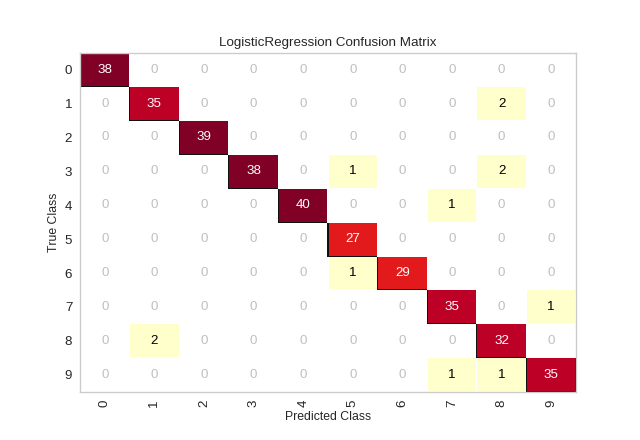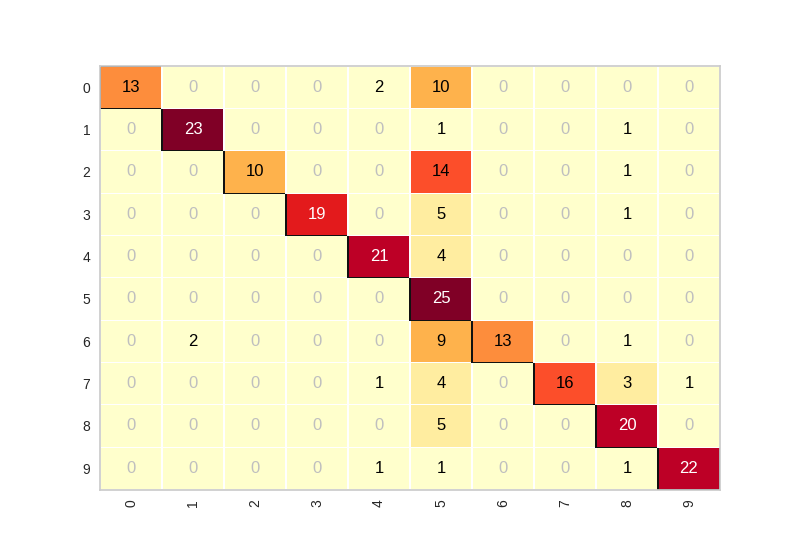python中使用keras训练mnist模型,用yellowbrick绘制模型的confusion_matrix(混淆矩阵)可视化
代码如下:
1 import lmdb 2 import numpy as np 3 import tensorflow as tf 4 import binascii 5 import caffe 6 import matplotlib.pyplot as plt 7 import PIL.Image 8 from io import BytesIO 9 10 import keras 11 from keras import Sequential 12 from keras.layers import Dense, Flatten, Dropout, MaxPool2D, Conv2D 13 from keras.layers.normalization import BatchNormalization 14 15 from sklearn.metrics import confusion_matrix 16 from sklearn.preprocessing import LabelEncoder 17 from yellowbrick.style.palettes import color_sequence 18 from yellowbrick.style import find_text_color 19 20 21 cmap = color_sequence("YlOrRd") 22 23 with open('/workspace/jobs/20200114-013226-34ca/val.txt', 'r') as f: 24 l = f.readlines() 25 26 y_test = [] 27 for i in l: 28 y_test.append(int(i.split(' ')[1][0])) 29 30 y = np.array(y_test) 31 labels = np.unique(y) 32 33 env_db = lmdb.open('/workspace/jobs/20200114-013226-34ca/val_db') 34 35 input_ids = [] 36 input_data = [] 37 38 with env_db.begin() as txn: 39 cursor = txn.cursor() 40 41 for key, value in cursor: 42 datum = caffe.proto.caffe_pb2.Datum() 43 datum.ParseFromString(value) 44 s = BytesIO() 45 s.write(datum.data) 46 s.seek(0) 47 img = PIL.Image.open(s) 48 img = np.array(img) 49 img = img.flatten() 50 51 input_ids.append(key) 52 input_data.append(img) 53 54 y_train = np.asarray(input_data) 55 y_train = y_train.reshape(-1, 28, 28, 1) 56 57 # keras mnist network 58 model = Sequential() 59 model.add(Conv2D(32, kernel_size=(3, 3),activation='relu',kernel_initializer='he_normal',input_shape=(28,28,1))) 60 model.add(Conv2D(32, kernel_size=(3, 3),activation='relu',kernel_initializer='he_normal')) 61 model.add(MaxPool2D((2, 2))) 62 model.add(Dropout(0.20)) 63 model.add(Conv2D(64, (3, 3), activation='relu',padding='same',kernel_initializer='he_normal')) 64 model.add(Conv2D(64, (3, 3), activation='relu',padding='same',kernel_initializer='he_normal')) 65 model.add(MaxPool2D(pool_size=(2, 2))) 66 model.add(Dropout(0.25)) 67 model.add(Conv2D(128, (3, 3), activation='relu',padding='same',kernel_initializer='he_normal')) 68 model.add(Dropout(0.25)) 69 model.add(Flatten()) 70 model.add(Dense(128, activation='relu')) 71 model.add(BatchNormalization()) 72 model.add(Dropout(0.25)) 73 74 model.add(Dense(10, activation='softmax')) 75 76 model.compile(loss='mse', 77 optimizer=keras.optimizers.RMSprop(), 78 metrics=['accuracy']) 79 80 y2 = keras.utils.to_categorical(y, 10) 81 model.fit(y_train, y2, epochs=100, batch_size=32) 82 83 y_pred = model.predict_classes(y_train) 84 85 yp = np.asarray(y) 86 if yp.dtype.kind in {"i", "u"}: 87 idx = yp 88 else: 89 idx = LabelEncoder().fit_transform(yp) 90 y_true = np.asarray(labels)[idx] 91 92 yp = np.asarray(y_pred) 93 if yp.dtype.kind in {"i", "u"}: 94 idx = yp 95 else: 96 idx = LabelEncoder().fit_transform(yp) 97 y_pred = np.asarray(labels)[idx] 98 99 c_m = confusion_matrix(y_true, y_pred, labels=labels) 100 101 print("c_m >>>>>>> \n", c_m) 102 103 class_count = dict(zip(*np.unique(y_true, return_counts=True))) 104 selected_class_counts = [] 105 for c in labels: 106 try: 107 selected_class_counts.append(class_count[c]) 108 except KeyError: 109 selected_class_counts.append(0) 110 class_counts = np.array(selected_class_counts) 111 112 cm_display = c_m[::-1, ::] 113 n_classes = len(labels) 114 X, Y = np.arange(n_classes + 1), np.arange(n_classes + 1) 115 116 ax = plt.gca() 117 118 ax.set_ylim(bottom=0, top=cm_display.shape[0]) 119 ax.set_xlim(left=0, right=cm_display.shape[1]) 120 121 xticklabels = labels 122 yticklabels = labels[::-1] 123 ticks = np.arange(n_classes) + 0.5 124 125 ax.set(xticks=ticks, yticks=ticks) 126 ax.set_xticklabels(xticklabels, rotation="vertical") 127 ax.set_yticklabels(yticklabels) 128 129 edgecolors = [] 130 131 for x in X[:-1]: 132 for y in Y[:-1]: 133 value = cm_display[x, y] 134 svalue = "{:0.0f}".format(value) 135 136 base_color = cmap(value / cm_display.max()) 137 text_color = find_text_color(base_color) 138 139 if cm_display[x, y] == 0: 140 text_color = "0.75" 141 142 cx, cy = x + 0.5, y + 0.5 143 ax.text( 144 cy, 145 cx, 146 svalue, 147 va="center", 148 ha="center", 149 color=text_color 150 ) 151 lc = "k" if xticklabels[x] == yticklabels[y] else "w" 152 edgecolors.append(lc) 153 154 vmin = 0.00001 155 vmax = cm_display.max() 156 157 ax.pcolormesh( 158 X, 159 Y, 160 cm_display, 161 vmin=vmin, 162 vmax=vmax, 163 edgecolor=edgecolors, 164 cmap=cmap, 165 linewidth="0.01", 166 ) 167 168 # plt.show() 169 plt.savefig("/data/domon/confusion_matrix.png")
其实yellowbrick中有api可以直接实现,以上代码为拆解源码,实现自定义网络与自定义数据集来实现混淆矩阵的模型可视化。
yellowbrick实现如下:
from sklearn.datasets import load_digits from sklearn.model_selection import train_test_split as tts from sklearn.linear_model import LogisticRegression from yellowbrick.classifier import ConfusionMatrix # 将特征为8*8的像素图像转为单个特征数组X,标签为y digits = load_digits() X = digits.data y = digits.target X_train, X_test, y_train, y_test = tts(X, y, test_size =0.2, random_state=11) model = LogisticRegression(multi_class="auto", solver="liblinear") # 创建混淆矩阵模型 cm = ConfusionMatrix(model, classes=[0,1,2,3,4,5,6,7,8,9]) # 训练模型 cm.fit(X_train, y_train) # score方法内对测试数据进行预测,并从scikit-learn创建confusion_matrix图像 cm.score(X_test, y_test) # 显示图片 cm.show()
yellowbrick混淆矩阵可视化结果:

自定义-混淆矩阵可视化结果(模型 epochs=50,测试图片数量:250张):

有需要改进的地方请提示,谢谢!



 浙公网安备 33010602011771号
浙公网安备 33010602011771号